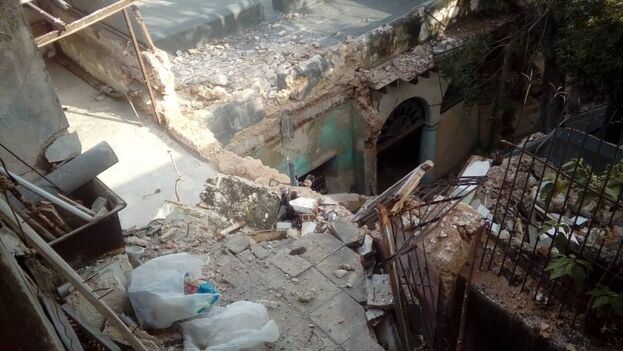
14ymedio, Serafín Martínez, Havana, 17 November 2020 — A week after having lived their worst nightmare, the residents of 355 Teniente Rey Street, between Aguacate and Villegas, in Old Havana, still do not believe that part of the three-story building where they have lived crowded together for years collapsed, an incident that it has left them living amid dangerous ruins and without institutional aid.
The victims remember the noise they sensed at two in the morning on Monday, November 9, when an area of the third floor roof where the water tanks were placed collapsed and fell on the building’s shared collective bathrooms. The partial collapse did not result in human casualties, but did cause significant material damage.
The hydro-sanitary facilities of the building were completely destroyed and the turbine and the cistern were also buried under the rubble. This system had supplied water to each of the small units inside a building that had been suffering from serious structural problems and advanced deterioration for years.
Neglys López Guerrero, age 29, who is 28 weeks pregnant and has two children ages 11 and 4, details to 14ymedio that on the day of the accident they immediately called the police and firefighters who “came without delay, but since no one was hurt they left without doing anything.”
“The officials of the Housing Institute told us that the building will be propped up and the third floor will be demolished, if the architects approves it; so that later we residents of the other floors can fix our apartments with our own means,” adds López Guerrero, who it does not have the financial resources to undertake the repairs.
However, she is relieved to have been able to stay building despite the danger. “We cannot go to shelters because our belongings, which we obtained with so much sacrifice, would stay here and be lost,” she says, a common position among the victims of building collapses who reject collective shelters.
“They took us out for two nights to sleep in the kindergarten and in the House of Combatants, but then they informed us that no one else would be coming and that we stayed here at our own risk. When they told me that what mattered was to preserve lives, I asked them that if lives only mattered at night.”
“What we aspire to is a place to save our lives that are in imminent danger, as well as to protect our property. If the building is not whole, as everything seems to indicate, then let them assign us housing to pay for and live with dignity,” says the young woman.
Another neighbor, Mercedes Castillo, 58, shares López Guerrero’s demands. “We were a total of 14 people, including four minors.” The two families living on the third floor were transferred to a shelter and the authorities “promised to prop up the building so that we could start fixing the apartments on our own, but the promise has not yet begun to be fulfilled.”
“The collapse even affected the school next door and the next door neighbors, but no one has come here, not even to collect the rubble. We have not had water since then and last night they sent us a water-truck. We are desperate. We cannot live like this in fear of our lives,” explains Castillo.
For her part, Mireya Guerrero, 50, noted that the “building has never been repaired. For many years it has been declared threatened with collapse and the Historian’s Office did not make any arrangements, not even propping it up. Despite the fact that it was reported as a critical housing situation at all levels including proposals in the meetings of the electoral district of the People’s Power.”
“On the ground floor there was a state carpentry workshop, which they closed due to complaints from neighbors, because the vibrations made the walls move. This misfortune happened with these blocks in [Covid-19] quarantine. We are like prisoners inside the building and with the jail about to collapse,” she says. “The food they brought us has been very bad, we can’t take it anymore.”
As of December 2018, Cuba had a housing deficit of almost one million residential units, which was also the last time the official press published numbers about the problem; the data have not been updated since. The experts believe that these numbers have been surpassed by the reality of a housing stock that is deteriorating day after day.
____________
COLLABORATE WITH OUR WORK: The 14ymedio team is committed to practicing serious journalism that reflects Cuba’s reality in all its depth. Thank you for joining us on this long journey. We invite you to continue supporting us by becoming a member of 14ymedio now. Together we can continue transforming journalism in Cuba.
